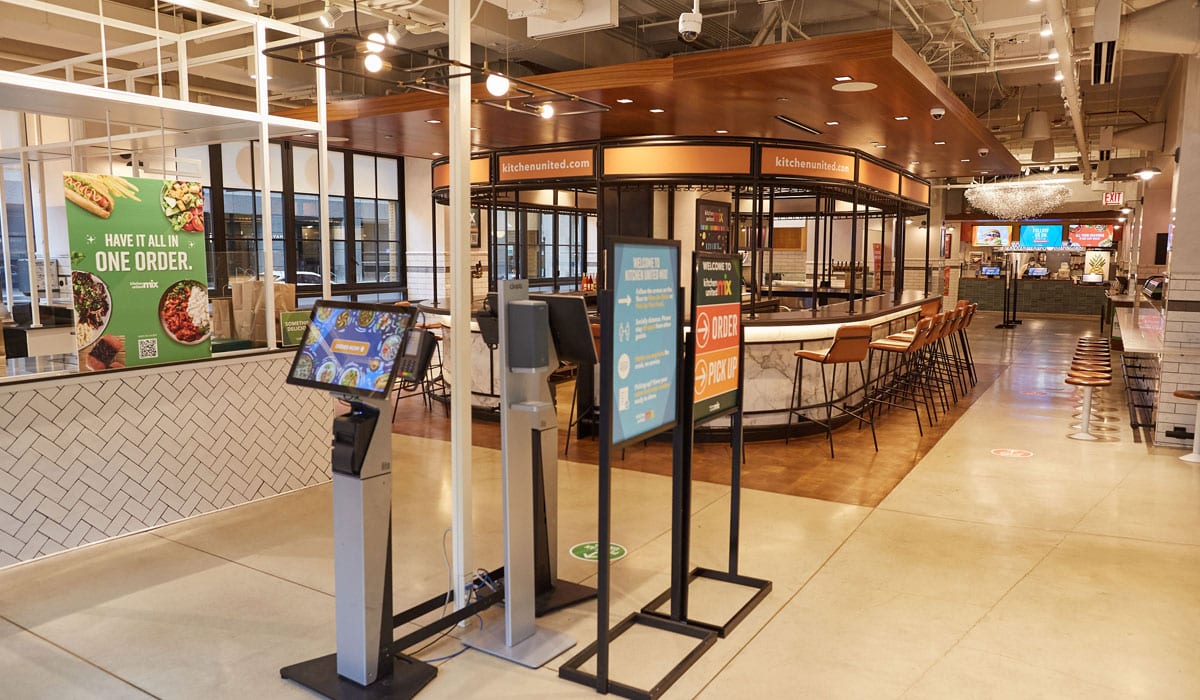Kitchen United on Thursday announced a partnership with Simon Property Group to launch the off-premises platform “Grab Go Eat.”
Grab Go Eat is a new platform that “allows restaurants, food court operators, and specialty food vendors at Simon properties to expand their reach, secure new customers, and streamline off-premises operations,” Kitchen United said.
Restaurants located within Simon properties can use the platform to facilitate inbound to-go orders. These orders can then be distributed to on-site food lockers, or to stores and tables for in-mall delivery. The first Simon properties where this service will be available are the Del Amo Fashion Center in Torrance, California, and the Roosevelt Field mall in Garden City, New York.
The new “Grab Go Eat” initiative will also enable customers to order from multiple restaurants in a single transaction for pickup or delivery. Customers who order from inside the mall can choose whether food is delivered to their table or any store within the shopping center.
Additionally, they can opt to skip lines by ordering through the platform and pick up directly from the restaurant or on-site food lockers.
When it comes time to order, customers tap into several channels to send in their ticket. Kitchen United’s kiosks located within the malls, website, and mobile app will provide customers the opportunity to order food from as many restaurants as they like under one transaction.
Designated pickup stations located outdoors will also be part of the platform’s model. These stations will mimic drive-thru windows, Kitchen United CEO Michael Montagano says, adding customers and delivery drivers can drive up to the stations and get their orders from a Kitchen United employee. Designated parking for the pickup stations will also be made available, making the process more streamlined for delivery drivers and customers looking to get in and out.
The ability to streamline a single order to various restaurants is something Montagano says separates this platform from other third-party ordering systems.
Grab Go Eat uses a proprietary tech stack, originally developed for Kitchen United. It does most of the heavy lifting when it comes time to divvy out orders with items from multiple restaurants. The proprietary technology makes it so orders can be sent to the specific restaurants and also accounts for firing times of different menu items.
In other words, hot food is made first and cold food is made last, no matter what restaurant is preparing it.
“Our system understands the volume that any kitchen is experiencing an understands the traditional fire times,” he says. “It can orchestrate between various items and various kitchens to make sure that all the restaurant partners can live cohesively within the platform and at the end, the customer is getting hot food that they expect to be hot and cold food that they expect to be cold.”
Coupled with the proprietary tech stack is a lower take rate, which Montagano says allows the customer and restaurant partner to save money. The Kitchen United CEO adds fees associated with Grab Go Eat are competitive compared to other platforms like DoorDash and Grubhub. He says the lower take rate paired with the ability to order from multiple restaurants generally leads to larger tickets.
“They are ordering more food when they have the option to order what they want,” he says. “If there is more food being ordered on the platform, that allows us to pass along the savings to both sides of the market.”
Another benefit the Grab Go Eat platform provides is a boon to business during slow hours. Montagano says one of the main goals of the platform is to drive incremental volume to their business partners during dayparts that would otherwise be underwhelming.
He says the partnership with Simon Property Group is a sign the demand for off-premises dining is going to continue to accelerate. He adds the Grab Go Eat platform will be beneficial for both customers and mall staff by making the ordering and serving process easier and more streamlined while also allowing restaurants in those spaces to expand their reach and grow their customer base.
“There’s only upside,” he says. “Our goal is to raise brand awareness … to drive more volume. We’re effectively giving free marketing to our restaurant partners in addition to the increased volume.”
These additional avenues of revenue are vital to any restaurant, but especially those located within shopping malls, which had already noticed a decline in business pre-pandemic.
Expanding the reach of restaurants located within shopping malls is necessary if they’re to keep up with trends in the industry.
According to The NPD Group’s year-end report, restaurant delivery has grown by triple digits over the past two years.
Carry-out orders are also an integral part of the off-premise model, representing more than a third of business, clocking in at 37 percent of all orders, according to NPD.













